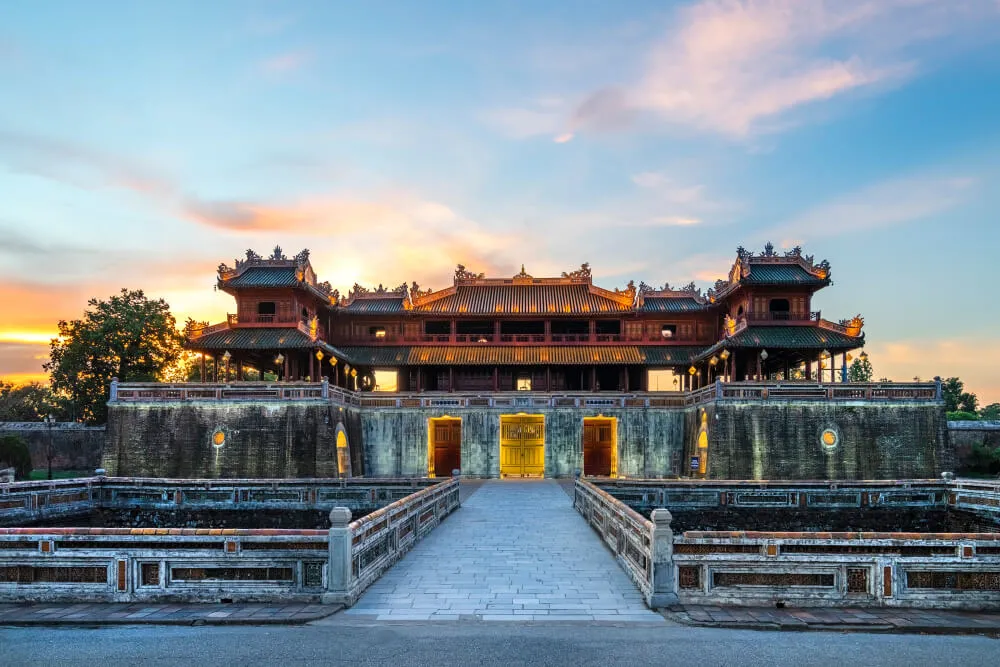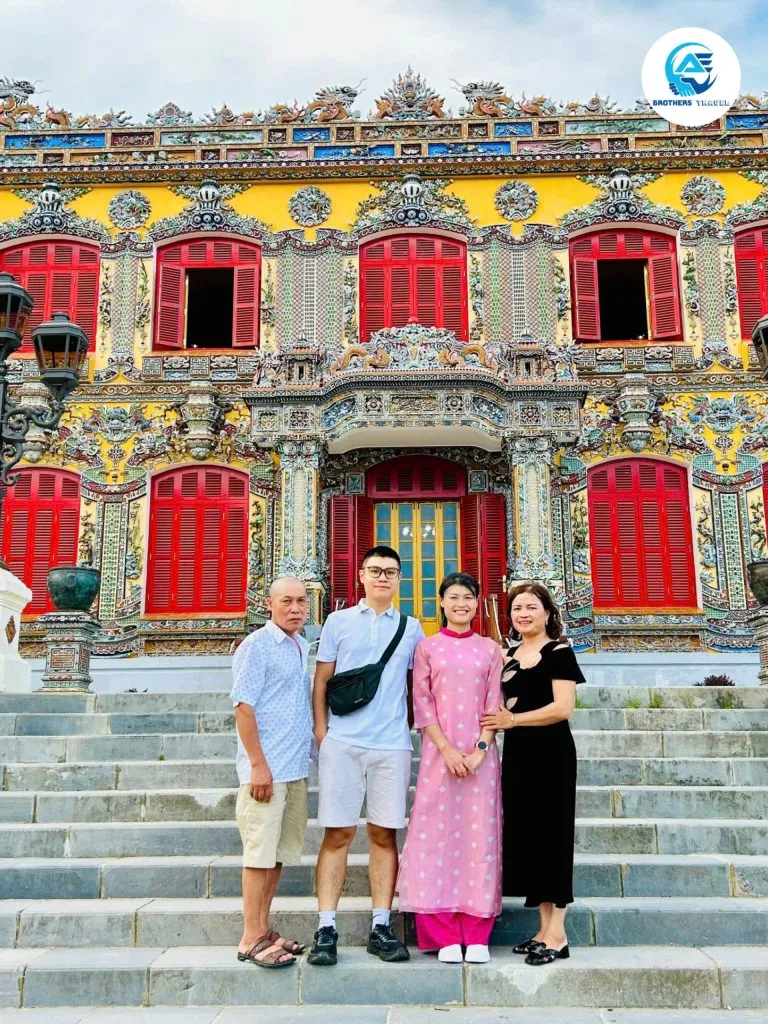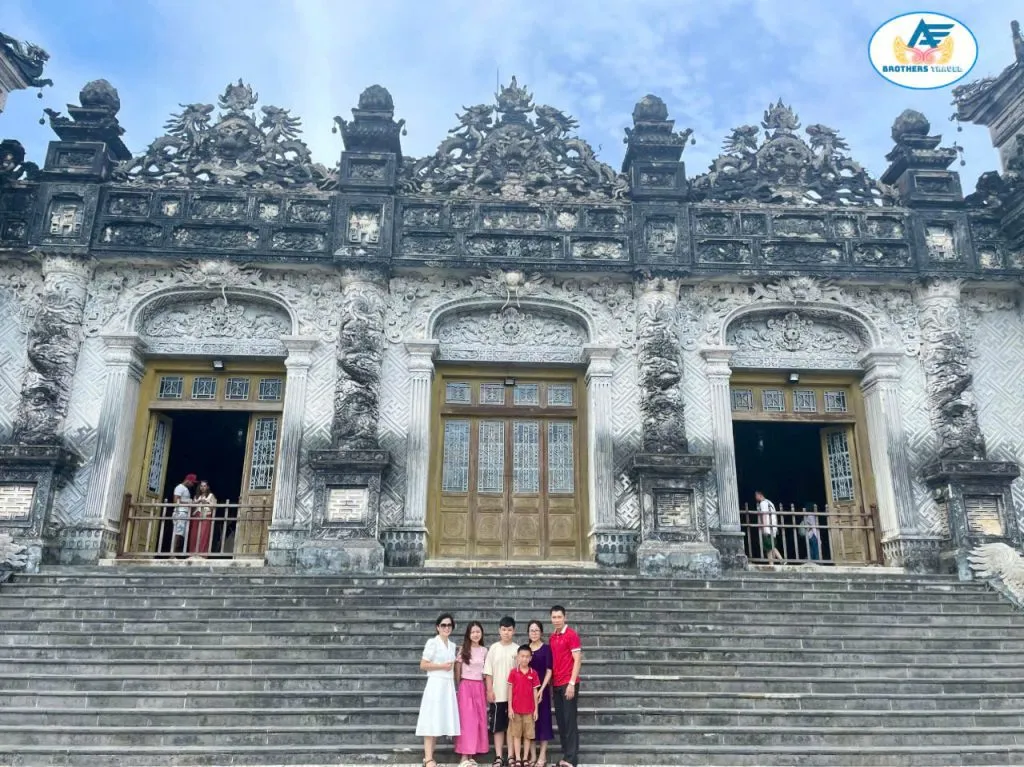Hue, the serene and captivating former capital of Vietnam, is more than just a city; it’s a living museum preserving the glorious imprints of the Nguyen Dynasty. Visiting Hue is like stepping into a mesmerizing historical space, where ancient architectural marvels, majestic royal tombs, and legendary tales intertwine, creating a unique and profound cultural tapestry. Among the countless attractions in Hue, the Imperial City and the royal tombs hold a special place in visitors’ hearts. These are not merely historical relics but also symbols of power, culture, and art from a dynasty that ruled Vietnam for over 140 years.
This article by “Du lịch khắp thế gian” (Travel Around the World) will serve as a detailed guide, accompanying you on a complete exploration of Hue’s Imperial City and royal tombs. We will delve into the history, architecture, and hidden stories behind each structure, helping you not only visit but also truly understand and appreciate the immense cultural value that Hue offers. Join us as we begin our journey to discover the Imperial City and royal tombs of Hue, to fully experience the ancient and majestic beauty of the former capital.
Hue Imperial City – Witness to the Nguyen Dynasty’s History
The Hue Imperial City, also known as the Citadel, is a symbol of the Nguyen Dynasty’s power, the last feudal dynasty of Vietnam. Constructed from 1805 to 1832 under the reigns of Emperors Gia Long and Minh Mang, the Imperial City was not only the residence of the royal family but also the political and cultural center of the country. Covering an expansive area of over 500 hectares, the Hue Imperial City is enclosed by a robust system of ramparts, rivers, and canals, creating a solid defensive structure and an architectural space harmonizing with nature.
Discovering the Unique Architecture of Hue Imperial City
The Hue Imperial City is a vast architectural complex comprising three concentric citadels: Kinh Thanh (Outer Citadel), Hoang Thanh (Royal Citadel), and Tu Cam Thanh (Forbidden Purple Citadel). Each citadel has its own distinct function and architecture, clearly reflecting feudal ideology and Hue’s imperial architectural artistry.
- Kinh Thanh (Outer Citadel): The outermost citadel, serving to protect the entire Royal Citadel and Forbidden Purple Citadel areas. The Outer Citadel is built in a square shape, with a perimeter of nearly 10 km, including 10 main gates and numerous defensive structures.
- Hoang Thanh (Royal Citadel): The second citadel, located inside the Outer Citadel, is the administrative area and the residence of the emperor and the royal family. The Royal Citadel is home to important architectural works such as Ngo Mon Gate, Thai Hoa Palace, Can Chanh Palace, Dien Tho Residence, Truong Sanh Residence, and numerous temples.
- Tu Cam Thanh (Forbidden Purple Citadel): The innermost citadel, located behind the Royal Citadel, is the private residence of the emperor and the royal family. The Forbidden Purple Citadel is built discreetly and solemnly, including palaces, pavilions, and royal gardens.
Upon entering the Hue Imperial City, visitors will be amazed by the grandeur and sophistication of the architectural structures. From the majestic Ngo Mon Gate, the main gate leading into the Royal Citadel, to the magnificent Thai Hoa Palace, where important court ceremonies took place, each structure embodies distinct historical and artistic values.

Ngo Mon Gate, with its unique Ngo Phung pavilion architecture, is not only an entrance but also a symbol of Hue Imperial City. The Ngo Phung Pavilion, with its 5 curved tile roofs symbolizing the five elements, creates an elegant and majestic beauty. Standing on Ngo Mon Gate, visitors can take in a panoramic view of the Imperial City and the poetic Perfume River.
Thai Hoa Palace, the center of the Royal Citadel, is where important court ceremonies of the dynasty took place. The palace is built in the trùng thiềm điệp ốc architectural style (double-roofed and overlapping), with a massive system of ironwood columns and a magnificent hoàng lưu ly (yellow glazed) tile roof. Inside Thai Hoa Palace, the emperor’s throne is placed solemnly, representing the supreme power of the Son of Heaven.

Kien Trung Palace, a unique architectural work within the Hue Imperial City, offers a different kind of beauty. Built during the reign of Emperor Khai Dinh, Kien Trung Palace is a harmonious blend of traditional Vietnamese imperial architecture and French architectural styles. With intricate floral patterns, colorful stained-glass windows, and decorative details bearing the imprint of Western art, Kien Trung Palace creates a space that is both ancient and modern, reflecting the unique cultural fusion of Hue.
Must-See Attractions within Hue Imperial City
- Ngo Mon Gate: The main south gate of the Royal Citadel, featuring the unique Ngo Phung pavilion architecture.
- Thai Hoa Palace: Where the emperor held court and organized important ceremonies.
- Can Chanh Palace: Where the emperor worked and received daily guests.
- Dien Tho Residence: Residence of the Empress Dowager.
- Truong Sanh Residence: Residence of the Grand Empress Dowager.
- Hien Lam Cac Pavilion: Dedicated to worshiping Nguyen Dynasty emperors with great contributions.
- The Mieu Temple: Dedicated to worshiping Nguyen Dynasty emperors.
- Kien Trung Palace: Unique architectural work combining Asian and European styles.
- Co Ha Garden: Royal garden with peaceful scenery and unique architecture.
Hue Royal Tombs – Architectural Beauty and Historical Tales
Hue is not only famous for its Imperial City but also known as the “land of tombs” with the system of mausoleums of the Nguyen Dynasty emperors. Each tomb is a unique architectural work, reflecting the personality, preferences, and conceptions of the afterlife of each emperor. Hue’s royal tombs are not just the resting places of emperors but also exquisite works of architectural and sculptural art, harmonizing with the poetic natural landscape, creating a beauty that is both majestic and romantic.
Khai Dinh Tomb – A Unique Blend of East-West Architecture
Khai Dinh Tomb, located on Chau Chu Mountain, is one of the most beautiful and unique tombs in Hue. Built from 1920 to 1931, the tomb is a harmonious combination of traditional Eastern architecture and Western Gothic and Romanesque architectural styles. Compared to other tombs, Khai Dinh Tomb has a smaller area but is extremely elaborate and sophisticated.

A special feature of Khai Dinh Tomb is that the main building materials are cement, brick, tile, ceramics, and glass. The walls, columns, and ceilings are decorated with thousands of pieces of ceramics and glass pieced together, creating extremely vivid and vibrant paintings and patterns. Inside the tomb, Thien Dinh Palace is the main structure, housing the statue of Emperor Khai Dinh and his altar tablet. Thien Dinh Palace is lavishly decorated with murals, reliefs, and intricate carvings.
Minh Mang Tomb – Harmony Between Architecture and Nature
Minh Mang Tomb, also known as Hieu Lang, located on Cam Ke Mountain, is one of the largest and most beautiful tombs in Hue. Built from 1840 to 1843, under the reign of Emperor Thieu Tri, according to the will of Emperor Minh Mang. Minh Mang Tomb is designed in the traditional Vietnamese architectural style, with a harmonious combination of architecture and nature.
The entire Minh Mang Tomb is laid out on a vertical axis, with architectural structures arranged symmetrically, harmonizing with the surrounding natural landscape. From the majestic Dai Hong Mon Gate, through the spacious Bai Dinh courtyard, to the solemn Sung An Palace and the poetic Trang Thanh Lake, each structure has its own unique beauty, contributing to a complete and impressive architectural ensemble. Minh Mang Tomb is not only the emperor’s resting place but also a beautiful park, where visitors can immerse themselves in nature and feel the peace and tranquility.
Tu Duc Tomb – Romantic and Poetic Beauty
Tu Duc Tomb, also known as Khiem Lang, is located in a narrow valley in Thuong Ba village, about 7 km from Hue city center. Built from 1864 to 1867, it is one of the tombs with the most unique architecture and beautiful scenery in Hue. Tu Duc Tomb is not only the emperor’s resting place but also a vast royal garden, where Emperor Tu Duc often came to rest, work, and compose poetry during his lifetime.
Tu Duc Tomb has a strong romantic architectural style, with a harmonious combination of architecture and nature. The blue Luu Khiem Lake, the poetic Tinh Khiem Island, the simple Luong Khiem Palace, and the modest tomb, all create a peaceful, tranquil, and poetic space. Visiting Tu Duc Tomb, visitors not only admire the unique architecture but also immerse themselves in the beautiful nature and feel the artistic soul of Emperor Tu Duc.
Suggested Itinerary for Visiting Hue Imperial City and Royal Tombs in One Day
To have a complete tour of Hue Imperial City and royal tombs in one day, you can refer to the following suggested itinerary:
- Morning: Visit Hue Imperial City (Dai Noi). Start from Ngo Mon Gate, go through Thai Hoa Palace, Can Chanh Palace, Dien Tho Residence, Truong Sanh Residence, Hien Lam Cac Pavilion, The Mieu Temple, and end at Kien Trung Palace. Visiting the Imperial City takes about 2-3 hours.
- Lunch: Have lunch at restaurants and eateries specializing in Hue cuisine. You can enjoy famous dishes such as Bun Bo Hue (Hue beef noodle soup), Com Hen (mussel rice), Banh Beo (water fern cake), Banh Khoai (crispy pancake)…
- Afternoon: Visit royal tombs. You can choose to visit 2-3 typical tombs such as Khai Dinh Tomb, Minh Mang Tomb, and Tu Duc Tomb. Each tomb is about 10-15 km from Hue city center, and the travel and visit time for each tomb is about 1-2 hours.
Note:
- Wear comfortable shoes for easy movement within the Imperial City and tombs.
- Bring a hat, sunscreen, and drinking water, especially in the summer.
- When visiting religious sites and tombs, dress politely and discreetly.
- You can rent a motorbike, car, or cyclo to travel between attractions.
- Bring a Hue tourist map for easy navigation and directions.
Conclusion
Hue Imperial City and royal tombs are not only historical relics but also precious gems of Vietnamese culture. Visiting Hue, exploring the Imperial City and tombs, you will travel back in time, learning about the history, culture, and architecture of the Nguyen Dynasty. Hopefully, with the information and suggestions in this article, you will have a truly meaningful and memorable trip to Hue. Come and feel the ancient, majestic, and romantic beauty of the former capital Hue, to better understand a part of the heroic history of the Vietnamese nation.